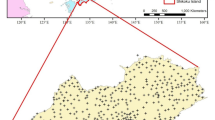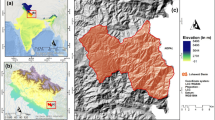Abstract
High-resolution terrain data are crucial for gravity field modelling in mountainous regions. In areas without national digital elevation models (DEMs) available, fill-ins from global models have to be used. For this purpose, the global models GTOPO30 (30″ resolution) and SRTM3 (3″ resolution) are considered. The SRTM3 model has been released recently from the analysis of the Shuttle Radar Topography Mission and covers the latitudes between 60°N and 54°S, while the GTOPO30 model is a global public domain data set completed already in 1996.
In this contribution, 1″ × 1″ national DEMs for Germany are used to evaluate the global models. The differences between the best national models and the SRTM3 data show a standard deviation of 7.9 m with maximum differences up to about 300 m. The largest differences are located in opencast mining areas and result from the different epochs of the DEMs. Histograms of the differences reveal a clear deviation from the normal distribution with a long tail towards too high SRTM3 elevations. The evaluation of GTOPO30 shows that the longitudes should be increased by 30″ (one block) in Germany. For the shifted GTOPO30 DEM, the standard deviation of the differences with respect to the best national model is 6.8 m, roughly 75 % smaller than for the original model.
Access this chapter
Tax calculation will be finalised at checkout
Purchases are for personal use only
Preview
Unable to display preview. Download preview PDF.
Similar content being viewed by others
References
AMilGeo (1992). Elevation Model DHM/M745. Amt für Militärisches Geowesen, Euskirchen, pers. comm..
Bamler, R. (1999). The SRTM Mission: A World-Wide 30 m Resolution DEM from SAR Interferometry in 11 Days. In: D. Fritsch and R. Spiller (eds.): Photogrammetric Week 99, Wichmann Verlag Heidelberg: 145–154.
Denker, H. (1988). Hochauflösende regionale Schwerefeldmodellierung mit gravimetrischen und topographischen Daten. Wiss. Arb. Fachr. Verm.wesen, Univ. Hannover, Nr. 156.
Denker, H., W. Torge (1998). The European gravimetric quasigeoid EGG97 — An IAG supported continental enterprise. IAG Symposia, Vol. 119:249–254, Springer Verlag.
Forsberg, R., M.G. Sideris (1989). On topographic effects in gravity field approximation. In: E Keylso, K. Poder, C.C. Tscherning (eds.): Festschrift to Torben Krarup, Geodaetisk Institut, Meddelelse No. 58: 129–148, Copenhagen.
Forsberg, R., C.C. Tscherning (1981). The use of height data in gravity field approximation by collocation. Journal of Geophys. Research 86: 7843–7854.
JPL (2004). SRTM — The Mission to Map the World. Jet Propulsion Laboratory, California Inst. of Techn., http://www2.jpl.nasa.gov/srtm/index.html.
LP DAAC (2004). Global 30 Arc-Second Elevation Data Set GTOPO30. Land Process Distributed Active Archive Center, http://edcdaac.usgs.gov/gtopo30/gtopo30.asp.
NGA (1996). Performance specification Digital Terrain Elevation Data (DTED). National Geospatial-Intelligence Agency, Document MIL-PRF-89020A.
Sideris, M.G., R. Forsberg (1991). Review of geoid prediction methods in mountainous regions. IAG Symposia, Vol. 106: 51–62, Springer Verlag.
Showstack, R. (2003). Digital Elevation Maps Produce Sharper Image of Earth’s topography. EOS, Transactions, American Geophysical Union, Vol. 84, No. 37: 363.
USGS (2004). US Geological Survey, ftp://edcsgs9.cr.usgs.gov/pub/data/srtm/.
Author information
Authors and Affiliations
Editor information
Editors and Affiliations
Rights and permissions
Copyright information
© 2005 Springer-Verlag Berlin Heidelberg
About this paper
Cite this paper
Denker, H. (2005). Evaluation of SRTM3 and GTOPO30 Terrain Data in Germany. In: Jekeli, C., Bastos, L., Fernandes, J. (eds) Gravity, Geoid and Space Missions. International Association of Geodesy Symposia, vol 129. Springer, Berlin, Heidelberg. https://doi.org/10.1007/3-540-26932-0_38
Download citation
DOI: https://doi.org/10.1007/3-540-26932-0_38
Publisher Name: Springer, Berlin, Heidelberg
Print ISBN: 978-3-540-26930-4
Online ISBN: 978-3-540-26932-8
eBook Packages: Earth and Environmental ScienceEarth and Environmental Science (R0)




